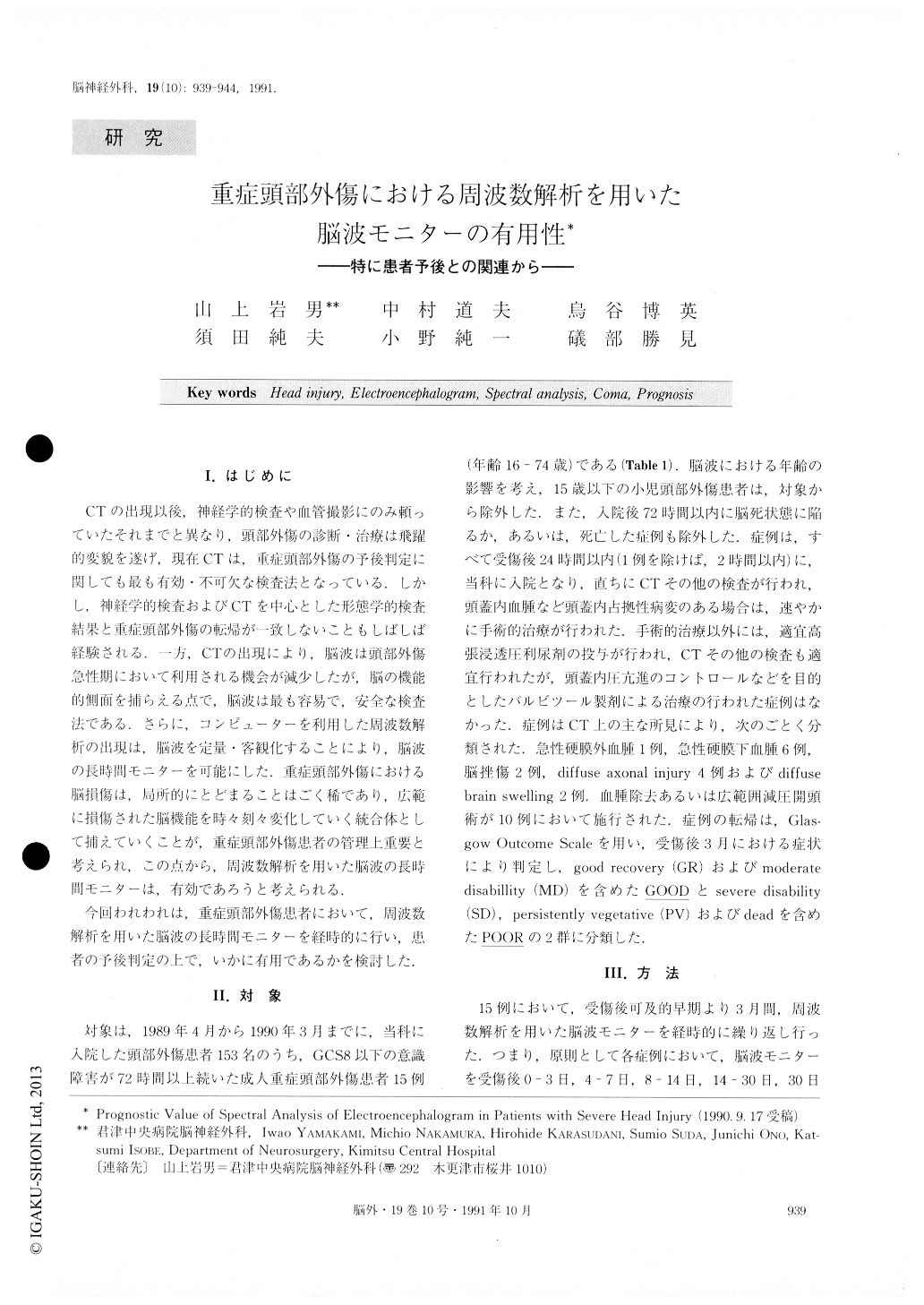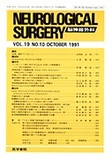Japanese
English
- 有料閲覧
- Abstract 文献概要
- 1ページ目 Look Inside
I.はじめに
CTの出現以後,神経学的検査や血管撮影にのみ頼っていたそれまでと異なり,頭部外傷の診断・治療は飛躍的変貌を遂げ,現在CTは,重症頭部外傷の予後判定に関しても最も有効・不可欠な検査法となっている.しかし,神経学的検査およびCTを中心とした形態学的検査結果と重症頭部外傷の転帰が一致しないこともしばしば経験される.一方,CTの出現により,脳波は頭部外傷急性期において利用される機会が減少したが,脳の機能的側面を捕らえる点で,脳波は最も容易で,安全な検査法である,さらに,コンピューターを利用した周波数解析の出現は,脳波を定量・客観化することにより,脳波の長時間モニターを可能にした.重症頭部外傷における脳損傷は,局所的にとどまることはごく稀であり,広範に損傷された脳機能を時々刻々変化していく統合体として捕えていくことが,重症頭部外傷患者の管理上重要と考えられ,この点から,周波数解析を用いた脳波の長時間モニターは,有効であろうと考えられる.
今回われわれは,重症頭部外傷患者において,周波数解析を用いた脳波の長時間モニターを経時的に行い,患者の予後判定の上で,いかに有用であるかを検討した.
Abstract
To determine the prognostic value of elec-troencephalogram (EEG) in patients with severe head injury, fifteen adult patients were examined for three months after trauma. All patients (age : 16 - 74 years old) remained comatose (Glasgow Coma Scale : less than 8) for more than 72 hours. Ten out of 15 cases were surgically treated. Barbiturates were not used in any patient for the sake of controlling the increased in-tracranial pressure. Three months after trauma, the cli-Meal Outcome of each patient was evaluated using Glasgow Outcome Scale (GOOD : good recovery / moderate disability, POOR : severe disability / persis-tently vegetative / dead).
EEG was examined repeatedly for 3 months after trauma ; 56 EEG recordings were performed on 15 cases. Each EEG recording was never for less than 12 hours and EEG was recorded from the bilateral parietal electrodes. Using EEG TREND MONITOR (NIHON-KODEN) , the spectral analysis of EEG was performed in five frequency bands (delta, theta, alpha - 1, alpha -2, beta) and the EEG power of each frequency hand was shown as the percentage of total EEG power (% FREQ BAND) . The findings of each % FREQ BAND was classified into the following four groups. 1) slow-monotonous : The EEG power was comprised invari-ably and almost exclusively of low frequency bands (i.e. delta and theta) , and the “slow-fast constant” which is the power of slow waves (delta and theta) di-vided by the power of fast waves (alpha - 1, alpha - 2, and beta) was stable. 2) changeable : The “slow-fast constant” is clearly smaller than the slow-monotonous and it shows temporary changes almost regularly. 3) monotonous : The “slow-fast contant” is invariably stable, however it is not as big as that found in the slow-monotonous. 4) alpha-coma : The “slow-fast con-stant” is small (i.e. the EEG power is occupied pre-dominantly with the high frequency band). However it is invariably stable.
Five out of 15 cases showed POOR clinical outcome ; most of them (4 cases) showed slow-monotonous per-sistently since the acute phase of trauma (< 7 days of trauma) and thereafter. Ten out of 15 cases had GOOD clinical outcome ; seven out of them showed change-able in the acute phase of trauma. In the second week of trauma, there was a transient increase of EEG power in the low frequency bands in five cases.
The result indicates that 1) the persistency of slow-monotonous EEG augurs a poor prognosis for the trauma patient, and 2) a changeable EEG in the acute phase of a trauma augurs a good prognosis for the pa-tient. Repeated recordings of EEG, using spectral analysis, are beneficial to determine the prognosis for a patient with severe head injury.

Copyright © 1991, Igaku-Shoin Ltd. All rights reserved.


